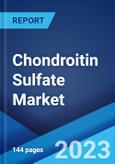The global chondroitin sulfate market size reached US$ 1.5 Billion in 2023. Looking forward, the publisher expects the market to reach US$ 2.1 Billion by 2032, exhibiting a growth rate (CAGR) of 3.81% during 2023-2032.
Chondroitin sulfate (CS) is a water-soluble polymer comprising alternating N-Acetylgalactosamine and glucuronic acid, which is naturally found in the cartilage, bone and cornea of animals. CS (C6H13NO5) is anti-atherogenic, inflammatory, thrombogenic and assists in the performance of coagulant activities. Consequently, it is utilized in oral delivery of insulin, proteins and peptides and as a skin substitute and biomaterial for wound healing in the healthcare sector.
CS acts as a precursor for inhibiting degradation, stimulating synthesis and improving the healing of articular cartilage. This represents one of the primary factors escalating the demand for CS-based injectable hydrogels in cartilage tissue engineering for fabricating purposes. Moreover, as it is an enzymatically biodegradable polysaccharide and has high water solubility and lack of mechanical stability, CS is modified with materials like collagen to be utilized in scaffold matrices and other drug delivery applications.
Furthermore, it is being used in dietary supplements for relieving pain and disability of individuals with musculoskeletal pathologies or osteoarthritis. In line with this, CS serves as a template for generating hydroxyapatite nanocrystals, thereby contributing to the market growth. It is also gaining traction as an antistatic agent in the cosmetics industry for manufacturing hair conditioning products.
Chondroitin sulfate (CS) is a water-soluble polymer comprising alternating N-Acetylgalactosamine and glucuronic acid, which is naturally found in the cartilage, bone and cornea of animals. CS (C6H13NO5) is anti-atherogenic, inflammatory, thrombogenic and assists in the performance of coagulant activities. Consequently, it is utilized in oral delivery of insulin, proteins and peptides and as a skin substitute and biomaterial for wound healing in the healthcare sector.
CS acts as a precursor for inhibiting degradation, stimulating synthesis and improving the healing of articular cartilage. This represents one of the primary factors escalating the demand for CS-based injectable hydrogels in cartilage tissue engineering for fabricating purposes. Moreover, as it is an enzymatically biodegradable polysaccharide and has high water solubility and lack of mechanical stability, CS is modified with materials like collagen to be utilized in scaffold matrices and other drug delivery applications.
Furthermore, it is being used in dietary supplements for relieving pain and disability of individuals with musculoskeletal pathologies or osteoarthritis. In line with this, CS serves as a template for generating hydroxyapatite nanocrystals, thereby contributing to the market growth. It is also gaining traction as an antistatic agent in the cosmetics industry for manufacturing hair conditioning products.
Key Market Segmentation:
The publisher provides an analysis of the key trends in each sub-segment of the global chondroitin sulfate market report, along with forecasts at the global, regional and country level from 2024-2032. Our report has categorized the market based on source, form and application.Breakup by Source:
- Bovine
- Swine
- Poultry
- Shark
- Others
Breakup by Form:
- Powder
- Tablet
- Others
Breakup by Application:
- Pharmaceuticals and Nutraceuticals
- Animal Feed
- Personal Care and Cosmetics
- Others
Breakup by Region:
- North America
- United States
- Canada
- Asia-Pacific
- China
- Japan
- India
- South Korea
- Australia
- Indonesia
- Others
- Europe
- Germany
- France
- United Kingdom
- Italy
- Spain
- Russia
- Others
- Latin America
- Brazil
- Mexico
- Others
- Middle East and Africa
Competitive Landscape:
The competitive landscape of the industry has also been examined along with the profiles of the key players being Bioiberica S.A.U., BRF S.A., HeBei SanXin Industrial Group, Maypro Industries Inc., Merck KGaA, Pacific Rainbow International Inc., Qingdao Wantuming Biological Products Co. Ltd., Seikagaku Corporation, Sino Siam Biotechnique Company Limited, Sioux Pharm Inc., Synutra International Inc. and ZPD A/S.Key Questions Answered in This Report:
- How has the global chondroitin sulfate market performed so far and how will it perform in the coming years?
- What has been the impact of COVID-19 on the global chondroitin sulfate market?
- What are the key regional markets?
- What is the breakup of the market based on the source?
- What is the breakup of the market based on the form?
- What is the breakup of the market based on the application?
- What are the various stages in the value chain of the industry?
- What are the key driving factors and challenges in the industry?
- What is the structure of the global chondroitin sulfate market and who are the key players?
- What is the degree of competition in the industry?
Table of Contents
1 Preface3 Executive Summary11 Value Chain Analysis13 Price Analysis
2 Scope and Methodology
4 Introduction
5 Global Chondroitin Sulfate Market
6 Market Breakup by Source
7 Market Breakup by Form
8 Market Breakup by Application
9 Market Breakup by Region
10 SWOT Analysis
12 Porters Five Forces Analysis
14 Competitive Landscape
List of Figures
List of Tables
Companies Mentioned
- Bioiberica S.A.U.
- BRF S.A.
- HeBei SanXin Industrial Group
- Maypro Industries Inc.
- Merck KGaA
- Pacific Rainbow International Inc.
- Qingdao Wantuming Biological Products Co. Ltd.
- Seikagaku Corporation
- Sino Siam Biotechnique Company Limited
- Sioux Pharm Inc.
- Synutra International Inc.
- ZPD A/S
Methodology

LOADING...
Table Information
| Report Attribute | Details |
|---|---|
| No. of Pages | 141 |
| Published | August 2024 |
| Forecast Period | 2023 - 2032 |
| Estimated Market Value ( USD | $ 1.5 Billion |
| Forecasted Market Value ( USD | $ 2.1 Billion |
| Compound Annual Growth Rate | 3.8% |
| Regions Covered | Global |
| No. of Companies Mentioned | 12 |









